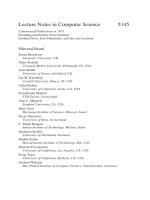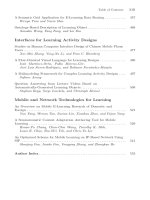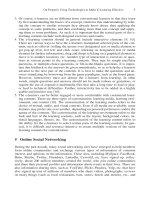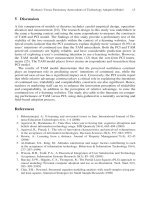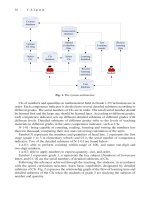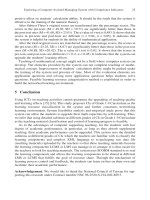Lecture Notes in Computer Science- P22 pdf
Bạn đang xem bản rút gọn của tài liệu. Xem và tải ngay bản đầy đủ của tài liệu tại đây (213.23 KB, 5 trang )
The Practice and Experience Sharing of Three-Year Peer Coaching Program in Taiwan 95
all significantly higher than those on their posttests, t=3.48, p=.00, t=2.80,
p=.01, and t=2.50, p=.02, respectively; for coaches, t=5.31, p=.00, t=5.47,
p=.00, and t=5.10, p=.00, respectively. These results showed that both LFs
and coaches did improve their skills and practice after training (at least 6
months later), including the skill in computer technology (S), the ability to
integrate technology into teaching (A), and the frequency of integrating
technology into teaching (F).
Note: The skill in computer technology (S); the ability to integrate technology into teaching
(A); The frequency of integrating technology into teaching (F)
Fig. 4. Results of LFs’ S & P Survey Fig. 5. Results of coaches’ S & P Survey
7.2.4 Local Facilitators’ Attitude Survey
A total of 45 and 44 LFs participated in the 2nd and 3rd year attitude survey, respec-
tively. The results show that teachers are pleased to participate in the promotion of
coaches’ training if bonuses, certificates, and some practical assistance are provided.
(1) 83% of teachers obtained information from educational websites and official
school documents.
(2) 81% of teachers took serious interest in the topic and hoped the activity would
be useful for their teaching.
(3) LFs are more willing to conduct Peer Coaching activities if a certificate or
prize and sufficient sponsorship are provided.
(4) Most LFs required assistance in printing handouts and sending out memos to
teachers.
(5) In terms of teacher acceptance and willingness to popularize Peer Coaching
activities: out of a total score of 5, means of 4.29 and 4.14 were observed for
the 2nd and 3rd year.
From the points given above, we observe that LFs who joined the Peer Coaching
activities agreed with the ideas of the Peer Coaching project and were glad to announce
related information to their co-workers. However, they had a low intention to hold Peer
Coaching activities because of the lack of administrative and resource support. From
the third and fourth points, we realized that more LFs would be willing to hold the
96 Y T. Carolyn Yang et al.
activity if basic resources and assistance were provided. We, thus, arranged to provide
some support, certificates and handouts which could be freely downloaded from our
website. Moreover, we offered the location, announcements and lecturers to assist in
holding Peer Coaching activities if required
7.3 Empirical Studies
We conducted two empirical researches (pretest and posttest quasi-experimental de-
signs) in the first and the second year, respectively. The main purpose of this 1st study
was to investigate the effectiveness of WebQuest in promoting higher order thinking and
learning motivation for elementary school students. The participants included 104 sixth
grade students in three classes at an elementary school in Tainan. The independent
variable was instructional strategy with three levels: traditional instruction, WebQuest
with no resources provided, and WebQuest with resources provided. The dependent
variables were the students’ HOT scores (critical thinking skills and problem solving
skills) and learning motivation. The results of this study are summarized as follows: (a)
no significant differences were found among the three groups in terms of students’
critical thinking skills; (b) students’ problem-solving skills improved after the imple-
mentation of WebQuest with resources provided; (c) no significant differences were
found among the three groups in terms of learning motivation; (d) the factors influencing
WebQuest instruction included HOT levels, process explicitness, learning style, and
description of links of resources; (e) the advantages of engaging students in WebQuest
instruction included an increase in students’ ICT skills, competence in searching web-
sites, and inquiry-based learning skills.
The purpose of the 2
nd
study was to explore the effectiveness of WebQuest on the
higher-order thinking, learning motivation, and English achievement of elementary
school students. The participants were 105 sixth-grade students in three classes en-
rolled at a large elementary school in Tainan. The independent variable was instruc-
tional strategy with three levels: traditional instruction (the comparison group),
WebQuest with resources (treatment I), and WebQuest with resources and then without
resources (treatment II). The dependent variables were problem-solving skills, learning
motivation, and English achievement. The results indicated: 1) There were no statis-
tically significant differences among these three classes in learning motivation. 2) For
problem solving skills, students who participated in treatments I and II performed
significantly better than those who participated in the comparison group. 3) For English
achievement, students who participated in treatment II performed significantly better
than those who participated in the comparison group and treatment I.
7.4 Interview
According to the frequency and length of time they surfed PBL.NET, four teachers
were chosen to take part in the interviews. These four teachers included two LFs, one
coach, and one influenced teacher. In addition, we also randomly selected six boys and
six girls for interviews who had teachers that had implemented WebQuest for school
teaching and student learning.
The Practice and Experience Sharing of Three-Year Peer Coaching Program in Taiwan 97
Teachers gained knowledge sharing and ease of teaching from PBL.NET. Teachers
were inspired to organize their teaching materials and display them systematically.
Also, they were encouraged to design attractive teaching activities. WebQuest enriches
students’ vocabulary and develops their innovation and creativity, and teachers ex-
perienced greater achievement. In addition, teachers’ suggestions about PBL.NET are
to design an interface with personalized features, to set up real-time interactive func-
tions for PBL.NET, and to increase the number of files that can be uploaded. There
were five reasons given by students about the benefits of WebQuest: increased ICT
skills, improved data coordination, enhanced webpage searching ability, improved
inquiry skills in the network, and increased student interest in “learning.”
7.5 Summary for Evaluation Results
Our evaluation of this project included four surveys, an empirical analysis of the re-
search results, and interviews. Based on the results from the Post-Unit Survey, our LFs
have a greater understanding of the training content. From the results of the Feedback
Survey for Peer Coaching Training, we realized that more practice time should be
included in the training workshop, and standard operation handbooks and handouts
should be provided for the LFs in training their coaches. These requests have been
processed by modifying our training schedule and providing training handbook,
handouts, and PowerPoint slides for LFs to download on our PBL.NET website. Ac-
cording to the Skills and Practice survey, teachers possessing high ICT skills do not
necessarily make effective use of them during their instruction. We, thus, need to fur-
ther encourage teachers to integrate their ICT skills into their teaching in the third year.
In addition, the results of the Local Facilitators’ Attitude Survey showed that teachers
are pleased to participate in the promotion of coaches’ training if bonuses, certificates
and some practical assistance are provided. Furthermore, the results of the empirical
research indicated that students’ problem solving skills and academic achievement
were significantly enhanced after WebQuest instruction. Although critical thinking and
learning motivation were not improved during the one-semester experiment, we will
continue to track and observe this progress during the next academic year. Finally, the
results of the interviews demonstrated that both teachers and students have learned new
teaching and learning skills from this Peer Coaching project. Students also increased
their ICT skills, and website-searching competence, as well as gained satisfaction in
learning accomplishments.
8 Conclusions
Due to the development of the Internet and the ICT skills, teachers have more oppor-
tunities to learn from each other to promote students’ better learning results. Under the
guidance of coaches, many teachers are adopting new strategies that appear to be re-
sulting in improved student learning (Bogner, 2002; Guiney, 2001; Wong & Nicotera,
2003). Hence, the Peer Coaching Program is one of the best ways for teachers to do
cooperative learning. In the planning of the program, there are many factors that need to
98 Y T. Carolyn Yang et al.
be considered. In order to make the program work more efficiently and successfully,
reflection and modification are very important processes. In addition, government
support and policies will affect the success of the promotion of the program. Therefore,
it is important to help the government understand the purpose of peer coaching so that
we can have more government support.
As to the planning of the program, we suggest that it should be designed as a
three-year program. In this way, not only will the training scale be enlarged, but more
importantly with such non-stop promotion, we can keep modifying the training process
to make the training program more effective. Also, to promote the program, the most
important elements are budget, resources, and specialists. Only with the cooperation of
industry, government, and academia can the national teaching environment and quality
be improved. Consequently, the training program will be implemented more efficiently
and successfully so that peer coaching can play an effective role in helping teachers
integrate technology into their classrooms in ways that encourage active learning by
their students. It is our hope that as more teachers are involved in this program, the
program can reach more teachers to develop standards-based instruction through en-
gaged learning and technology integration. In conclusion, with our continuous en-
deavor in the third year, this project, we believe, will inspire more creative
ICT-integrated teaching and learning to provide a better quality of K-12 instruction.
References
Austin, D.S.: New literacies: Are Colorado Teacher Education Programs Preparing Pre-service
Teachers to Use Technology in Their Learning Environments? Unpublished Dissertation,
University of Denver (2004)
Bogner, J.: Teacher Leadership and Peer Coaching (2002),
/>and_PeerCoaching.pdf
Dodge, B.: WebQuests: A Technique for Internet-Based Learning. Distance Educator 1, 10–13
(1995)
Guiney, E.: Coaching isn’t just for Athletes: The Role of Teacher Leaders. Phi Delta Kappan 82,
740–743 (2001)
Loucks-Horsley, S., Hewson, P.W., Love, N., Stiles, K.E.: Designing Professional Development
for Teachers of Science and Mathematics. Thousand Oaks, CA (1998)
Miller, N.N.: The Technology Float in Education Today. Science Activities 35, 3–4 (1998)
Saye, J.W.: Technology in the Classroom: The Role of Dispositions in Teacher Gatekeeping.
Journal of Curriculum and Supervision 13, 210–234 (1998)
Schwab, R.L.: Technology and the Changing Roles and Responsibilities of Teacher Educators.
In: Switzer, T. (ed.) In Log In or Log Out: Technology in 21st Century Teacher Education,
Washington, D.C (2000)
Tonkin, S., Baker, J.D.: Peer Coaching for Online Instruction: An Emerging Model for Faculty
Development. In: 19th Annual Conference on Distance Teaching and Learning (2006)
Wong, K., Nicotera, A.: Enhancing Teacher Quality: Peer Coaching as a Professional Devel-
opment Strategy a Preliminary Synthesis of the Literature (2003),
F. Li et al. (Eds.): ICWL 2008, LNCS 5145, pp. 99–110, 2008.
© Springer-Verlag Berlin Heidelberg 2008
eKnowledge Repositories in eLearning 2.0:
UNITE - a European-Wide Network of Schools
Christoph Hornung
1
, Andrina Granić
2
, Maja Ćukušić
2
, and Kawa Nazemi
1
1
Fraunhofer Institute for Computer Graphics, Darmstadt, Germany
{christoph.hornung,kawa.nazemi}@igd.fraunhofer.de
2
Faculty of Science, University of Split, Split, Croatia
{andrina.granic,maja.cukusic}@pmfst.hr
Abstract. The upcoming Web 2.0 technologies change the aspects of eLearning
fundamentally. The traditional paradigm of classroom teaching and homework
learning will develop further towards sharing experiences and knowledge in
word-wide social communities. Moreover, knowledge capturing in ambient en-
vironments gains more and more importance. These aspects characterize the
so-called eLearning 2.0. This paper describes a prototype of an eLearning 2.0
system covering the different aspects such as platform, pedagogy and scenarios.
The concepts presented here have been applied in the EU-project UNITE. The
implementation of this system in the setting of a European network of fourteen
schools is presented as an iterative four stage process, covering scenario plan-
ning and implementation, validation in addition to platform and process
improvement. Achieved intermediate results from the first iteration of the im-
plementation process are discussed and future work is presented.
Keywords: Web 2.0, eLearning 2.0, eKnowledge repositories, knowledge pro-
cessing, eLearning standards, e/mLearning.
1 Introduction
Nowadays eLearning solutions are mostly based on the Web 1.0 paradigm. Web 1.0
can be characterized as single user and data-download centred. With the upcoming
features of Web 2.0, this situation changes completely. Support of communities and
folksonomies, as well as communicating and collaborating user groups become preva-
lent. Moreover, these user groups also upload data to the web and, herewith, the Web
becomes a medium for group-based interaction. Consequently, application fields like
eLearning will change and develop further. Different aspects of this paradigm shift
are presented and the EU-project UNITE [1] as an application case offered.
The paper is structured as follows. Section 2 introduces state-of-the-art along with
challenges of eLearning 2.0 and the UNITE project. Section 3 concentrates on the
technical aspects of the design and implementation of eLearning 2.0 platforms
whereas section 4 focuses on enhanced eKnowledge repositories. Section 5 describes
the implementation of the e/mLearning platform in Spinut School. Finally, Section 6
concludes the paper and brings future plans.
